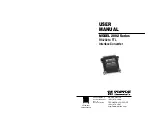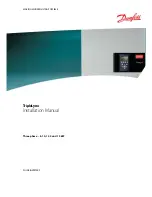
3-18
Displaying running status
To display the running status in hexadecimal format, each state has been assigned to bits 0 to 15 as
listed in Table 3.13. Table 3.14 shows the relationship between each of the status assignments and
the LED monitor display. Table 3.15 gives the conversion table from 4-bit binary to hexadecimal.
Table 3.13 Running Status Bit Assignment
Bit Notation
Content
Bit
Notation
Content
15 BUSY
"1" when function code data is
being written.
7
VL
"1" under voltage limiting control.
14
Always "0."
6
TL
"1" under torque limiting control.
"1" when the DC link bus voltage is
higher than the undervoltage
level.
13
WR
Always "0."
5
NUV
12 RL
"1" when communication is
enabled (when ready for run and
frequency commands via
communications link).
4
BRK "1"
during
braking.
"1" when the inverter output is
shut down.
11
ALM
"1" when an alarm has occurred.
3
INT
10
DEC
"1" during deceleration.
2
EXT
"1" during DC braking.
9 ACC
"1"
during
acceleration.
1
REV
"1" during running in the reverse
direction.
"1" during running in the forward
direction.
8
IL
"1" under current limiting control.
0
FWD
Table 3.14 Running Status Display
LED No.
LED4
LED3
LED2
LED1
Bit 15
14
13
12
11
10
9
8
7
6
5
4
3
2
1
0
Notation BUSY
WR
RL
ALM DEC ACC
IL
VL
TL
NUV BRK INT EXT REV FWD
Binary 1
0
0
0
0
0
1
1
0
0
1
0
0
0
0
1
Example
Hexa-
decimal
on the
LED
monitor
Hexadecimal expression
A 4-bit binary number can be expressed in hexadecimal format (1 hexadecimal digit). Table 3.15
shows the correspondence between the two notations. The hexadecimals are shown as they appear
on the LED monitor.
Table 3.15 Binary and Hexadecimal Conversion
Binary Hexadecimal Binary Hexadecimal
0 0 0 0
0
1 0 0 0
8
0 0 0 1
1
1 0 0 1
9
0 0 1 0
2
1 0 1 0
a
0 0 1 1
3
1 0 1 1
b
0 1 0 0
4
1 1 0 0
c
0 1 0 1
5
1 1 0 1
d
0 1 1 0
6
1 1 1 0
e
0 1 1 1
7
1 1 1 1
f
















































